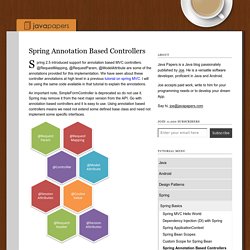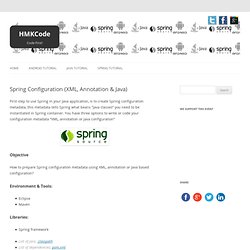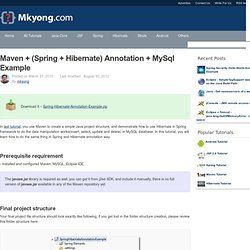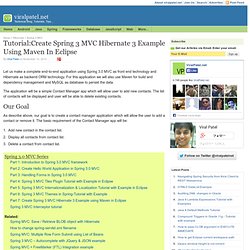

Spring Annotation Based Controllers. Spring 2.5 introduced support for annotation based MVC controllers.

@RequestMapping, @RequestParam, @ModelAttribute are some of the annotations provided for this implementation. We have seen about these controller annotations at high level in a previous tutorial on spring MVC. I will be using the same code available in that tutorial to explain the annotations. An important note, SimpleFormController is deprecated so do not use it. Spring may remove it from the next major version from the API. To brush up the basics of annotations I recommend you to go through my tutorial on java annotations. @Controller Annotation In spring-context first we need to declare a bean. Latest way of doing this is, enabling autodetection. Then add @Controller annotation to controllers. @RequestMapping Annotation @RequestMapping annotation is used to map a particular HTTP request method (GET/POST) to a specific class/method in controller which will handle the respective request.
Multi-action Controller <beans ... Spring Configuration (XML, Annotation & Java) First step to use Spring in your Java application, is to create Spring configuration metadata, this metadata tells Spring what beans “Java classes” you need to be instantiated in Spring container.

You have three options to write or code your configuration metadata “XML, annotation or Java configuration” Objective How to prepare Spring configuration metadata using XML, annotation or Java based configuration? Environment & Tools: EclipseMaven Libraries: Spring. Maven + (Spring + Hibernate) Annotation + MySql Example. In last tutorial, you use Maven to create a simple Java project structure, and demonstrate how to use Hibernate in Spring framework to do the data manipulation works(insert, select, update and delete) in MySQL database.

In this tutorial, you will learn how to do the same thing in Spring and Hibernate annotation way. Prerequisite requirement - Installed and configured Maven, MySQL, Eclipse IDE. The javaee.jar library is required as well, you can get it from j2ee SDK, and include it manually, there is no full version of javaee.jar available in any of the Maven repository yet. Final project structure Your final project file structure should look exactly like following, if you get lost in the folder structure creation, please review this folder structure here. Tutorial:Create Spring 3 MVC Hibernate 3 Example using Maven in Eclipse. Let us make a complete end-to-end application using Spring 3.0 MVC as front end technology and Hibernate as backend ORM technology.

For this application we will also use Maven for build and dependency management and MySQL as database to persist the data. The application will be a simple Contact Manager app which will allow user to add new contacts. The list of contacts will be displayed and user will be able to delete existing contacts. Our Goal As describe above, our goal is to create a contact manager application which will allow the user to add a contact or remove it. Add new contact in the contact list.Display all contacts from contact list.Delete a contact from contact list. Following is the screenshot of end application. Application Architecture We will have a layered architecture for our demo application. Getting Started For our Contact Manager example, we will use MySQL database. Creating Project in Eclipse Download the below source code: Maven Dynamic Web Project (6.7 KB) Spring MVC + Hibernate + MySQL Quick Start From Scratch.
Spring Injection with @Resource, @Autowired and @Inject » Source Allies Blog. Overview I’ve been asked several times to explain the difference between injecting Spring beans with ‘@Resource’, ‘@Autowired’, and ‘@Inject’.

While I received a few opinions from colleagues and read a couple of posts on this topic I didn’t feel like I had a complete picture. Annotations In order to explore the behavior of each annotation I fired up Spring Tool Suite and started debugging the code. I used Spring 3.0.5.RELEASE in my research. The Code I wanted to know how ‘@Resource’, ‘@Autowired’, and ‘@Inject’ resolved dependencies.
‘Person’ is a component and it implements ‘Party’. ‘Organization’ is a component and it implements ‘Party’. I setup a Spring context that scans both of these packages for beans marked with ‘@Component’. Tests Test 1: Ambiguous Beans.